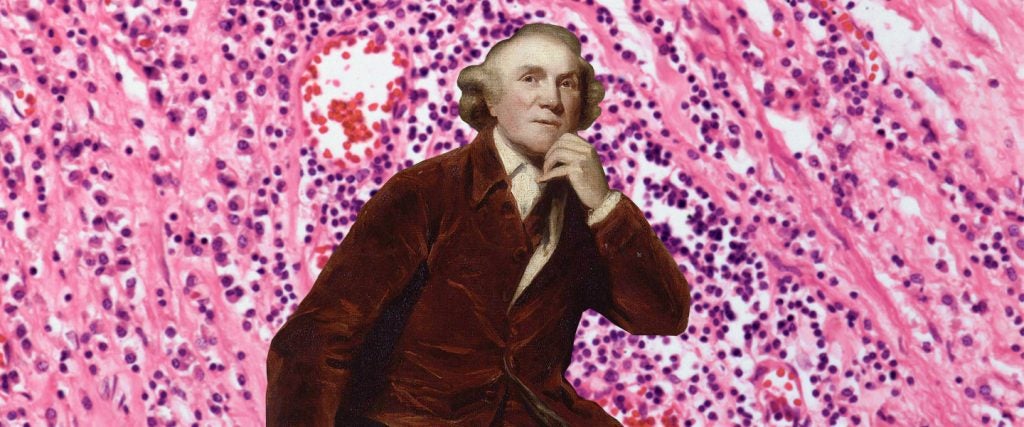Before the days of peer-reviewed journals, meta-analyses and large sample sizes, scientists often had to rely on data from a party of one — typically themselves. And 18th-century surgeon John Hunter, who was instrumental in the development of a smallpox vaccine and is still regarded as the father of “scientific surgery,” was no exception. Like many doctors of his time, Hunter was concerned about syphilis, which afflicted one out of five adults in London by the time he started practicing medicine in the early 1760s.
Hunter theorized that gonorrhea, in its early stages, was the same disease as syphilis. This would have been big if true since gonorrhea was much easier to treat and syphilis could be fatal. As the story goes, Hunter attempted to prove his theory by making several cuts into his own penis and dropping what he thought was the pus of a patient with gonorrhea onto his wounds. Unfortunately, Hunter failed to realize that the patient was infected with both gonorrhea and syphilis. This amounted to much more than just a rough weekend for the surgeon, who had just unknowingly compromised over 50 years of medical research, along with his health.
Hunter never directly confirmed or denied that he gave himself the STD, and historians still debate whether or not he inoculated himself in a “misbegotten experiment,” as it was described in the book Doctors: The Biography of Medicine, or a very unlucky anonymous man who got his penis mangled in the name of scientific inquiry, like the biography John Hunter 1728-1793 claims.
“I have read about Hunter’s experiment and his self-inoculation with syphilis and always thought if that was just something he told his wife,” practicing physician Rajnish Jaiswal jokes. “‘No honey, I didn’t get this STD from the housekeeper. This is all for science.’” But regardless of who he infected with his concoction, because he was so hell-bent on proving that syphilis and gonorrhea were the same illness, “his research and contributions in hindsight were detrimental to this field,” explains Jaiswal.
When Hunter published A Treatise on the Venereal Disease in 1786, in which he claimed that his theory on syphilis and gonorrhea was proven to be correct, he gave no clues as to the subject’s identity. “Some of his students later claimed that he had revealed to them in a lecture that he had inoculated himself, but this is hearsay,” historian Kevin Brown tells me. When Brown was doing research for his book on the history of syphilis, he concluded that the only other explanation was that Hunter paid a research assistant or tricked someone into it. “No informed consent was needed back then,” he notes.
What makes it likely that Hunter was self-experimenting is that “he needed a patient guaranteed to be free of previous infection and who could be observed on a daily basis over a number of years. He was perhaps the only person who met these criteria,” Brown points out. “His own health later deteriorated, which may have been the result of syphilitic infection, though there is no way of proving that.” Hunter died of a heart attack at the age of 65, about seven years following the experiment.
British journalist Wendy Moore, who profiled Hunter in her biography The Knife Man: Blood, Body Snatching and the Birth of Modern Surgery, agrees with Brown’s assessment, despite the lack of confirmation from Hunter himself. “I believe it’s clear from various sources that the experiment was on himself, in common with several other self-experiments he conducted,” she tells me. “As a result, he erroneously concluded that syphilis and gonorrhoea were the same disease — the same symptoms — which set back understanding of sexual diseases by several decades.”
So why did it take so long for the medical community to catch his mistake?
At the time, many doctors in Europe also believed that gonorrhea and syphilis were different stages of the same disease, so much so that they referred to it as “the unicast theory of syphilis,” Brown says. Moreover, after Hunter inoculated himself, he showed symptoms of gonorrhea within days and symptoms of syphilis within months. “Hunter continued to monitor the symptoms for three years, by which time he was satisfied that he had proved the unity of venereal disease,” Brown explains. However, this was centuries before scientists became aware of confirmation bias and the caveats of only studying a single subject. “Nowadays, this would be considered scientifically invalid and inconclusive, but in Hunter’s time, it was enough to come up with a concrete conclusion.”
Egos may have also gotten in the way. Among Hunter’s first vocal opponents was fellow surgeon Jesse Foot, who was “motivated by a strong dislike of Hunter and distrust of his methods.” Though Foot attacked Hunter’s work for generalizing from one case and failing to reference other authorities, “Foot himself believed that syphilis and gonorrhea were one disease; he just disliked Hunter,” Brown says.
In the end, Hunter may have held back the overall scientific understanding of both diseases — it wasn’t until the 1830s that French venereologist Philippe Ricord proved syphilis and gonorrhea were two different diseases — but not the treatment of it. Mercury continued to be the standard remedy, according to Brown. And when spirochaete was identified as the bacterium that causes syphilis, it was “possible to look for a ‘magic bullet’ against it,” he continues. The first of which was an arsenical compound called salvarsan, with penicillin becoming the standard treatment thereafter.
Somehow, though, Hunter’s massive medical folly didn’t taint his legacy — considered more a product of his times than a lunatic who cut open his own penis and mistakenly gave himself syphilis. Or as Brown puts it, “He remains an influential figure in the development of modern science, however murky and unscientific some of his practices may seem by today’s ethical codes and practices.”

